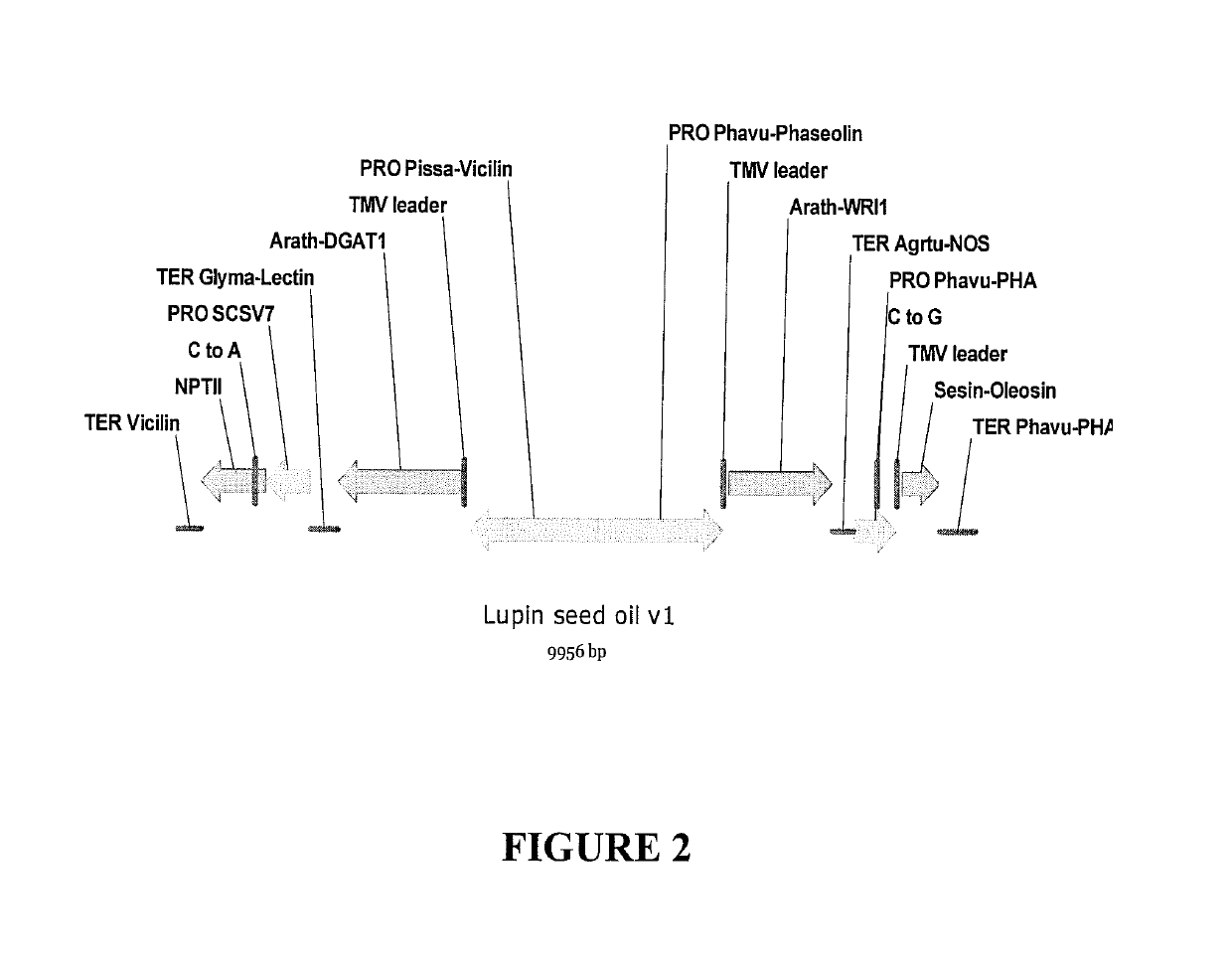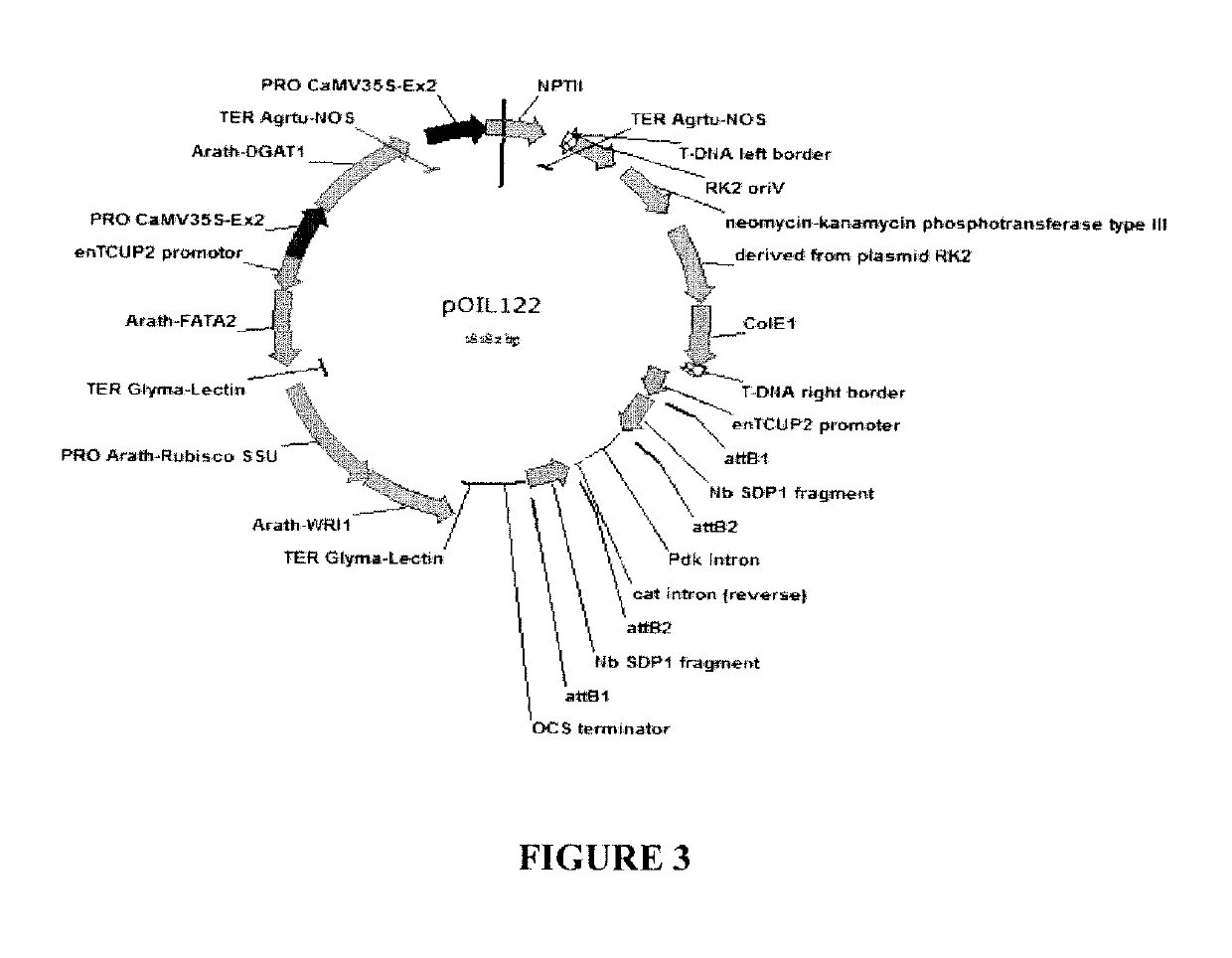Processes for producing industrial products from plant lipids
a technology of plant lipids and industrial products, applied in the direction of fatty-oil/fat separation, fatty acid chemical modification, fatty-oil/fat refining, etc., can solve the problem of moderate increase in seed or leaf oil content, and achieve the effect of increasing the export of c8
- Summary
- Abstract
- Description
- Claims
- Application Information
AI Technical Summary
Benefits of technology
Problems solved by technology
Method used
Image
Examples
example 1
aterials and Methods
Expression of Genes in Plant Cells in a Transient Expression System
[1155]Genes were expressed in plant cells using a transient expression system essentially as described by Voinnet et al. (2003) and Wood et al. (2009). Binary vectors containing the coding region to be expressed by a strong constitutive e35S promoter containing a duplicated enhancer region were introduced into Agrobacterium tumefaciens strain AGL1. A chimeric binary vector, 35S:p19, for expression of the p19 viral silencing suppressor was separately introduced into AGL1, as described in WO2010 / 057246. A chimeric binary vector, 35S:V2, for expression of the V2 viral silencing suppressor was separately introduced into AGL1. The recombinant cells were grown to stationary phase at 28° C. in LB broth supplemented with 50 mg / L kanamycin and 50 mg / L rifampicin. The bacteria were then pelleted by centrifugation at 5000 g for 5 min at room temperature before being resuspended to OD600=1.0 in an infiltratio...
example 4
g Oil Content in Vegetative Parts of Monocotyledonous Plants
[1182]Chimeric DNA constructs were designed to increase oil content in monocotyledonous plants, for example the C4 plant S. bicolor (sorghum), by expressing a combination of genes encoding WRI1, Z. mays LEC1 (Accession number AAK95562; SEQ ID NO:155), DGAT and Oleosin in the transgenic plants. Several pairs of constructs for biolistic co-transformation were designed and produced by restriction enzyme-ligation cloning, as follows.
[1183]The genetic construct pOIL136 was a binary vector containing three monocot expression cassettes, namely a selectable marker gene encoding phosphinothricin acetyltransferase (PAT) for plant selection, a second cassette for expressing DGAT and a third for expressing Oleosin. pJP136 was first produced by amplifying an actin gene promoter from Oryza sativa (McElroy et al., 1990) and inserting it as a blunt-ClaI fragment into pORE04 (Coutu et al., 2007) to produce pOIL094. pOIL095 was then produced...
example 5
g Oil Content in Dicotyledonous Plants
[1192]Oil content in the dicotyledonous plant species Trifolium repens (clover), a legume commonly used as a pasture species, was increased by expressing the combination of WRI1, DGAT and Oleosin genes in vegetative parts. The construct pJP3502 was used to transform T. repens by Agrobacterium-mediated transformation (Larkin et al., 1996). Briefly, the genetic construct pJP3502 was introduced into A. tumefaciens via a standard electroporation procedure. The binary vector also contained a 35S:NptII selectable marker gene within the T-DNA. The transformed Agrobacterium cells were grown on solid LB media supplemented with kanamycin (50 mg / L) and rifampicin (25 mg / L) and incubated at 28° C. for two days. A single colony was used to initiate a fresh culture. Following 48 hours vigorous culture, the Agrobacterium cells was used to treat T. repens (cv. Haifa) cotyledons that had been dissected from imbibed seed as described by Larkin et al. (1996). Foll...
PUM
| Property | Measurement | Unit |
|---|---|---|
| dry weight | aaaaa | aaaaa |
| pressure | aaaaa | aaaaa |
| pressure | aaaaa | aaaaa |
Abstract
Description
Claims
Application Information
 Login to View More
Login to View More - R&D
- Intellectual Property
- Life Sciences
- Materials
- Tech Scout
- Unparalleled Data Quality
- Higher Quality Content
- 60% Fewer Hallucinations
Browse by: Latest US Patents, China's latest patents, Technical Efficacy Thesaurus, Application Domain, Technology Topic, Popular Technical Reports.
© 2025 PatSnap. All rights reserved.Legal|Privacy policy|Modern Slavery Act Transparency Statement|Sitemap|About US| Contact US: help@patsnap.com



